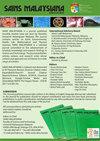Sound-Absorbing Material Based Oil Palm Frond Natural Fibres
IF 0.7
4区 综合性期刊
Q3 MULTIDISCIPLINARY SCIENCES
引用次数: 0
Abstract
Effective noise control is vital for improving living standards, but traditional sound absorbers pose health risks. Natural fibers offer a sustainable alternative, with consistent absorption rates across a broad frequency range. These fibers, widely available in Malaysia, are non-toxic, lightweight, renewable, and eco-friendly, making them an attractive option. The safety benefits of natural fibers further enhance their appeal as sound absorbers, making them an excellent choice for those concerned about environmental impact and personal health. This study will examine the effect of different thicknesses on the acoustic performance of natural fibers from oil palm fronds (OPF). The findings demonstrate that, when material density is 160 kg/m3, all thicknesses can achieve a good Sound Absorption Coefficient (SAC) of 0.8 or greater within 3600 - 6400 Hz range. However, at 180 kg/m3 density, only the 10 mm thickness sample has SAC of 0.8 or greater, but for 2800 - 6400 Hz range. It is worth noting that, across 0 - 6400 Hz, 10 mm thick and 180 kg/m3 density sample has higher SAC than 160 kg/m3 samples. Nevertheless, for 12 mm, 14 mm, and 16 mm thicknesses, SAC of 160 kg/m3 is higher than 180 kg/m3 after an interception point. Before that interception point, SAC of 160 kg/m3 is lower than 180 kg/m3. As thickness increases from 12 mm to 16 mm, the interception point decreases from 2100 Hz to 1600 Hz. The research demonstrates that various factors, such as frequency, density, thickness, and fiber structure, impact the acoustic performance of OPF LDF.基于油棕叶天然纤维的吸声材料
有效的噪声控制对提高生活水平至关重要,但传统的吸声器会带来健康风险。天然纤维提供了一种可持续的替代品,在广泛的频率范围内具有一致的吸收率。这些纤维在马来西亚广泛使用,无毒,轻便,可再生,环保,使它们成为一个有吸引力的选择。天然纤维的安全优势进一步增强了它们作为吸音器的吸引力,使它们成为那些关心环境影响和个人健康的人的绝佳选择。本研究将探讨不同厚度的天然纤维对油棕叶(OPF)声学性能的影响。研究结果表明,当材料密度为160 kg/m3时,在3600 ~ 6400 Hz范围内,所有厚度的吸声系数(SAC)均可达到0.8或更高。然而,在180 kg/m3密度下,只有10 mm厚度样品的SAC为0.8或更高,但在2800 - 6400 Hz范围内。值得注意的是,在0 - 6400 Hz范围内,10毫米厚和180 kg/m3密度的样本的SAC高于160 kg/m3的样本。然而,对于12mm、14mm和16mm厚度,截止点后的SAC为160 kg/m3,高于180 kg/m3。在截止点之前,160 kg/m3的SAC低于180 kg/m3。当厚度从12mm增加到16mm时,截止点从2100 Hz减小到1600 Hz。研究表明,频率、密度、厚度和纤维结构等因素都会影响OPF LDF的声学性能。
本文章由计算机程序翻译,如有差异,请以英文原文为准。
求助全文
约1分钟内获得全文
求助全文
来源期刊

Sains Malaysiana
MULTIDISCIPLINARY SCIENCES-
CiteScore
1.60
自引率
12.50%
发文量
196
审稿时长
3-6 weeks
期刊介绍:
Sains Malaysiana is a refereed journal committed to the advancement of scholarly knowledge and research findings of the several branches of science and technology. It contains articles on Earth Sciences, Health Sciences, Life Sciences, Mathematical Sciences and Physical Sciences. The journal publishes articles, reviews, and research notes whose content and approach are of interest to a wide range of scholars. Sains Malaysiana is published by the UKM Press an its autonomous Editorial Board are drawn from the Faculty of Science and Technology, Universiti Kebangsaan Malaysia. In addition, distinguished scholars from local and foreign universities are appointed to serve as advisory board members and referees.
 求助内容:
求助内容: 应助结果提醒方式:
应助结果提醒方式:


